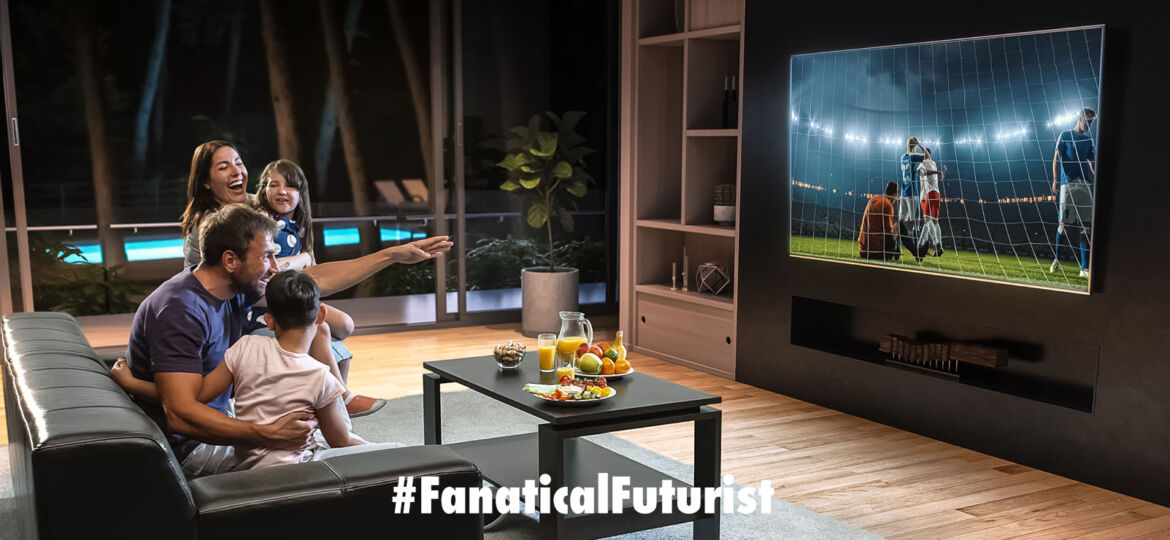
WHY THIS MATTERS IN BRIEF
Wires and cables suck but we’re stuck with them … or are we?
 Love the Exponential Future? Join our XPotential Community, future proof yourself with courses from XPotential University, read about exponential tech and trends, connect, watch a keynote, or browse my blog.
Love the Exponential Future? Join our XPotential Community, future proof yourself with courses from XPotential University, read about exponential tech and trends, connect, watch a keynote, or browse my blog.
I’ve been saying for years that one day TV’s, or just displays in general, will be completely wireless, and that when it comes to power they’ll be wirelessly charged. And, while we’ve seen wirelessly powered TV’s so far there’s never been a TV that’s completely wireless or cable free on all fronts – until now. Although that statement does come with one giant caveat in this case – that the TV’s battery powered. So we’re not quite at the finishing line yet.
At CES 2023, Displace showed how its futuristic 55-inch 4K TV utilizes a special pop-up camera to recognize gesture controls and a proprietary active-loop vacuum seal to adhere itself to walls while content’s streamed to it over WiFi.
Learn more about the TV
The gesture controls of the DisplaceTV that most caught our eye at the show were the ability to use your finger as a mouse to select particular on-screen channels/options, plus a fancy two-handed flourish to enlarge what’s on one screen to fill all four. By the way, such a configuration – a two-by-two grid of DisplaceTVs – would essentially create an 8K 110-inch TV capable of streaming four different channels at once. Or if you position them on different walls with their respective cameras popped up, you can enable your content to seamlessly follow you around the house.
In addition to gestures, you’ll also be able to control the TV with voice, touch, and an app. The display receives all its content from a separate base unit, into which you can plug all your video sources such as cable and streaming boxes, gaming console, Blu-ray player, and so on, somewhere else in the room. Thus your movies and shows stream from that box, which is potentially hidden from sight, to the actual display. In fact, a single base unit can send a signal to up to six different DisplaceTVs. And that’s why the display itself has no wires, plugs, ports or buttons – not even a power button to turn it on.
At less than 20 lb (9 kg), you can transport this svelte telly around the house and stick it to pretty much any smooth surface, including glass, concrete or drywall. Though it can store two batteries in its left side and two more in the right, it only needs one to be fully operational – thus allowing you to top off the other three, if necessary. When juiced up, all four batteries in the TV are rated to supply a staggering 180 hours of viewing – essentially a month’s worth of streaming TV and movies for a mind-numbing six hours a day.
Here’s a demonstration of the vacuum seal system in action:
If for some reason you forget to charge the batteries before you leave on holiday and the unit is in danger of falling off the wall, since ironically the vacuum seal requires power, the app will notify you and then deploy a series of two countermeasures to stick itself manually to the wall so it doesn’t tragically fall and crash. Apparently, they’ve thought of everything!
To wit, the company’s Founder & CEO, Balaji Krishnan, has quite a background in TV. Back in 2011, the serial entrepreneur founded Snapstick, a consumer device startup that brought the world’s first mobile-to-TV experience to peoples’ homes, and was acquired a few years later by TiVo. And then in 2015, he founded DabKick, which introduced both a smart streaming device and the ability for folks to livestream photos, music and videos all on the same screen.
When forming Displace, Krishnan hadn’t originally set out to create a wireless TV, but rather a series of smart displays around the house.
“We [had to] think backwards to see what are the things required to actually get to this mission,” Krishnan revealed to us at the company’s booth at CES. “And we wanted to remove all the friction points that people have with the biggest display you have in your home, which is television.” So they quite literally cut the cords and created their proprietary hot-swappable battery assembly system. Because as he put it, “You don’t want to be charging this TV every night like an iPad.”
Displace is currently taking reservations for their systems, each of which includes a base control unit, battery charging unit and four batteries per display. A refundable 10% deposit will lock in the following pricing: $2,999 for one DisplaceTV, $5,399 for two and $8,999 for four.
















